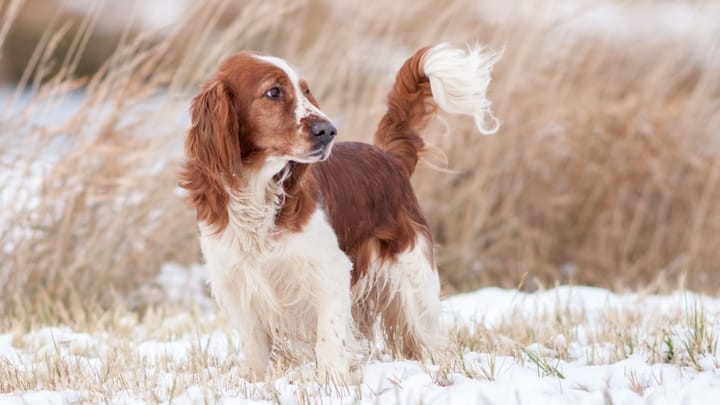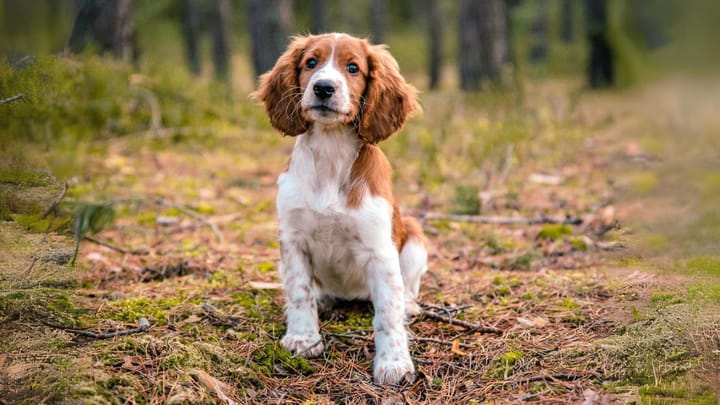Welsh Springer Spaniel
Other name: Welsh Springer


The Welsh Springer Spaniel is an outstanding athlete, who is just as happy playing ball in the garden as he is flushing birds, as a hunting sport. Sometimes the breed is confused with an English Springer Spaniel, but the remarkable red and white coat distinguishes this dog. He is brilliant with children and can certainly improve the family’s fitness levels with his athletic and energetic requirement levels.
|
Life expectancy |
The Welsh Springer Spaniel has a life expectancy of between 12 and 14 years |
|
Temperament |
|
|
Size |
Medium
|
|
Adult size |
Female
Between 17 and 18 in
Male
Between 18 and 19 in
|
|
Adult weight |
Female
Between 33 and 40 lb
Male
Between 40 and 44 lb
|
|
Coat colour
Kennel Club registration only accepts Welsh Springer Spaniel canines with the coat colour rich red and white. |
White Red |
|
Type of coat
Medium length hair. This breed has a stunning, silky coat, which feels flat or wavy when touched, rather than wiry. It is also quite dense to provide protection against the chilly and wet weather. Feathering is present on the dog’s tail, ears, underbody, chest and legs. |
Long |
|
Eye colour
This dog’s eyes are medium to dark brown in colour. |
Brown
|
|
Purchase price |
The Welsh Springer Spaniel costs between £420 and £835 |
The Welshie takes his name “Springer” from his movement to “spring” at any game he is hunting out. Because of his hunting capabilities, he has been a fond favourite of many sportsmen for over 200 years.
More details about the Welsh Springer Spaniel
Welsh Springer Spaniel: Origins and history
The Welsh Springer Spaniel is thought to be the oldest recognised Spaniel breed of dog. Although it was first recognised by the UK Kennel Club in 1902, images and depictions of similar dogs with red and white hair have been discovered dating back to the Renaissance period around the 16th century. He is understood to have ancestry from Roman dogs, meaning he is from an ancient breed.
During the 18th century, many Welsh gentry owned one of these gundogs, however their popularity boomed in Britain and Europe in later years. They were originally named Welsh Cockers, however this changed to the Welsh Springer Spaniel, when recognised by the UK Kennel Club.
Physical characteristics of the Welsh Springer Spaniel
Certainly a working dog, the Welsh Springer is of a medium size with a compact body. His slightly rounded head sports a square muzzle and either a brown or black nose. He has oval-shaped brown eyes and long ears that hang down the side of his face. The dog’s stunning, soft coat appears in a red and white pattern, often with ticking shading too. There is feathering around his tail and ears, belly, chest and on the back of the legs.
FCI classification of the Welsh Springer Spaniel
-
Group 8 - Retrievers - Flushing Dogs - Water Dogs
-
Section 2 : Flushing Dogs
Welsh Springer Spaniel: Characteristics
Welsh Springer Spaniel: Behaviour
Training a Welsh Springer Spaniel
Providing the pup’s training begins at a young age, this dog will be quite happy and eager to learn new tasks. The Welsh Springer is known to excel at a variety of canine agilities, including obedience skills, agility sessions and fly-ball, too. This dog loves nothing more than to train with his handler and to take part in joint tasks. A very smart dog who will be very focussed and keen to learn new skills, although try to avoid repetition and make sure to keep the training sessions interesting. Positive reinforcement is preferred, rather than any heavy handed methods. As they can sometimes be rather stubborn at times, too, lots of understanding and patience on the handler’s part is needed.
Welsh Springer Spaniel: Lifestyle
Breed compatibility Welsh Springer Spaniel
Welsh Springer Spaniel: Purchase price
Expect to pay between £420 and £835 depending on if the dog is a registered bloodline or not.
As a rough guide, the average monthly cost to care for and maintain a Welsh Springer dog is around £70 to £100. Of course, this depends on the type of food you give him, his veterinary care and vaccinations and his insurance policy premium.
Welsh Springer Spaniel: Shedding
Average
The coat of the Welsh Springer Spaniel sheds an average amount of hair throughout the year. You will probably notice balls of hair fluff collecting around the floor.
Welsh Springer Spaniel: Grooming
The coat of this dog is relatively easy to groom, with just a weekly brushing recommended. As he has floppy ears that easily get caught up in the shrubs when hunting, it’s advised that you inspect and clean them frequently, to prevent any ear infections.
Welsh Springer Spaniel: Health
When the Welsh Springer is well cared for, and fed a good quality, nutritious diet, his life expectancy is between 12 to 14 years.
Certainly a vigorous, hardy worker in a hunting capacity. This dog just loves being outdoors and enjoys hiking, running or engaging in other energetic activities.
The thick coat of the Welsh Springer provides comfort for him in both hot and cold temperatures. However, as a very active breed, care should be taken during very high temperatures to ensure he doesn’t suffer from heat exhaustion.
The dog’s dense coat certainly provides sufficient protection against the cold or wet weather.
In general, after any canine has been neutered or spayed, they are often prone to weight gain. This is exactly the case with the Welsh Springer Spaniel. Similarly, older dogs who are less active are more susceptible to gaining weight, which can be a problem in his later years.
- Glaucoma Gonio dysgenesis – Canine DNA testing can eliminate this from the breed
- Retinal atrophy
- Cataracts
- Hip dysplasia – Hip scoring is essential
- Epilepsy
- Ear problems due to his long, floppy ears
Do you want a Welsh Springer Spaniel dog ?
Oh no...
There are no Welsh Springer Spaniel adoption profiles at the moment...




